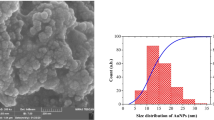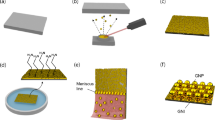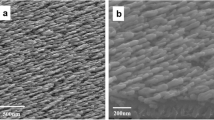Abstract
A glass-based surface-enhanced Raman scattering (SERS) substrate using 90 nm gold nanourchin (GNU) was fabricated as a localized surface plasmon resonance (LSPR) sensor. Self-assembly of GNU monolayer is achieved by silanizing the glass surface with amino-terminated (3-aminopropyl) triethoxysilane (APTES) and covalently grafting with thiol-terminated mercaptoundecanoic (MUA). Six substrates are used in vertical direction for immobilization of GNU at two concentrations of 5 pM (S1, S2, S3) and 15 pM (S4, S5, S6) for three sets of time 1, 3, and 5 h in each case, respectively, and one substrate (S7) is immersed horizontally at 15 pM for 5 h. The substrates are assessed using reflective surface-enhanced Fourier transform near-infrared (SEFT-NIR) and SERS. The results show that S3 (5 pM, 3 h) ≈ 96%, S4 (15 pM, 1 h) ≈ 97%, and S7 ≈ 97.8% have the highest GNU coverage, respectively. However, higher GNU coverage does not necessarily produce the maximum SERS signal as in our case S2 > S3 > S1 and S4 > S5 > S6. Principal component analysis (PCA) results can be interpreted as showing significant variance between the groups with less variation between the trials in the SEFT-NIR data, while the PC plots of the Raman data show that the spectra of all groups look very similar. Both techniques showed S3 and S4, and S7 as optimized substrates. Scanning electron microscopy (SEM) and atomic force microscopy (AFM) indicated a dispersed distribution of GNU with peak heights of ≤ 10 nm. This work is fundamentally important for designing and modeling LSPR-based nanosensors.
















Similar content being viewed by others
Data Availability
The data that support the findings of this study are available from the corresponding author upon reasonable request.
References
Zhou W, Gao X, Liu D, Chen X (2015) Gold nanoparticles for in vitro diagnostics. Chem Rev 115:10575–10636
Khosroshahi ME, Tajabadi M (2017) Multifunctional nanoplatform for targeted laser-induced hyperthermia and microscopy of breast cancer cells using SPION-based gold and folic acid conjugated nanodendrimers: an in vitro assay. J Nanomed Nanotechnol 8:1–11
Pankhurst Q, Connolly J, Jones S, Dobson J (2003) Applications of magnetic nanoparticles in biomedicine. J Phys D: Appl Phys 36:167–181
He H, Xie C, Ren J (2008) Nonbleaching fluorescence of gold nanoparticles and its applications in cancer cell imaging. Anal Chem 80:5951–6595
Khosroshahi ME, Tajabadi M (2016) Characterization and cellular fluorescence microscopy of superparamagnetic nanoparticles functionalized with third generation nanomolecular dendrimers: in-vitro cytotoxicity and uptake study. J Nanomater Mol Nanotechnol 5:1–11
Pattani V, Tunnell J (2012) Nanoparticle-mediated photothermal therapy: a comparative study of heating for different particle types. Lasers Surg Med 44:675–684
Liao SH, Liu CH, Bastakoti BP, Suzuki N, Chang Y, Yamauchi Y, Lin FH, Wu K (2015) Functionalized magnetic iron oxide/alginate core-shell nanoparticles for targeting hyperthermia. Int J Nanomed 10:3315–3328
Kim M, Lee JH, Nam JM (2019) Plasmonic photothermal nanoparticles for biomedical applications. Adv Sci 6:1–23
Gormley A, Larson N, Sadekar S, Robinson R, Ray A, Ghandehari H (2012) Guided delivery of polymer therapeutics using plasmonic photothermal therapy. Nano Today 7:158–167
Khosroshahi ME, Ghazanfari L, Hasannejad Z, Lenhert S (2015) Dynamics study and analysis of laser-induced transport of nanoferrofluid in water using fluorescein isothiocyanate (FITC) as fluorescence marker. Nanomed Nanotech 6:1–9
Licciardi M, Volsi AL, Mauro N, Scialabba C, Cavallaro G, Giammona G (2007) Preparation and characterization of inulin coated gold nanoparticles for selective delivery of doxorubicin to breast cancer cells. J Nanomater 2016:2078315
Willets K, Van Duyne R (2007) Localized surface plasmon resonance spectroscopy and sensing. An Phys Rev Chem 58:267–297
Petryayeva E, Krull U (2011) Localized surface plasmon resonance: nanostructures, bioassays and biosensing—a review. Anal Chim Acta 706:8–24
Jain P, Lee K, El-Sayed I, El-Sayed M (2006) Calculated absorption and scattering properties of gold nanoparticles of different size, shape, and composition: applications in biological imaging and biomedicine. J Phys Chem B 110:7238–7248
Noguez C (2007) Surface plasmons on metal nanoparticles: the influence of shape and physical environment. J Phys Chem 111:3806–3819
Hassannejad Z, Khosroshahi ME (2013) Synthesis and evaluation of time dependent optical properties of plasmonic–magnetic nanoparticles. Opt Mat 35:644–651
Khlebtsov B, Zharov V, Melnikov A, Tuchin V, Khlebtsov N (2006) Optical amplification of photothermal therapy with gold nanoparticles and nanoclusters. Nanotechnology 17:5167–5179
Nath N, Chilkoti A (2004) Label-free biosensing by surface plasmon resonance of nanoparticles on glass: optimization of nanoparticles size. Anal Chem 76:5370–5378
Wang C, Meloni M, Wu X, Zhuo M, He T, Wang J, Wang C, Dong P (2019) Magnetic plasmonic particles for SERS-based bacteria sensing: a review. AIP Adv 9:1–18
Ong T, Blanch E, Jones O (2020) SERS in environmental analysis monitoring and assessment. Sci Total Environ 720:1–12
Alvarez-Puebla R, Liz- Marzán L (2010) SERS-based diagnosis and biodetection. Small 6:604–610
Masson J (2017) Surface plasmon resonance clinical biosensors for medical diagnosis. ACS Sens 2:16–30
Tian Z, Ren B, Wu D (2002) Surface-enhanced Raman scattering: from noble to transition metals and from rough surfaces to ordered nanostructures. J Phys Chem B 106:9463–9483
López-Lorente ÁI (2021) Recent development on gold nanoparticles nanostructures for surface enhanced Raman spectroscopy: particle shape, substrates and analytical applications. A review. Anal Chimica Acta 1168:1–21
Bruzas I, Lum W, Gorunmez Z, Sagle L (2018) Advances in SERS substrates for lipid and protein characterization: sensing and beyond. Analyst 143:3990–4400
Wang Y, Wang E (2010) Nanoparticles SERS substrates. In: Schlucker S (ed) Surface enhanced Raman spectroscopy: analytical, biophysical and life science applications. Wiley-VCH, Weinheim, pp 39–69
Fortuni B, Inose T, Uezono S, Toyouchi S, Umemoto K, Sekine S, Fujita Y, Ricci M, Lu G, Masuhara A, Hutchison J, Latterini L, Uji-I H (2017) In situ synthesis of Au-shelled Ag nanoparticles on PDMS for flexible, long-life, and broad spectrum-sensitive SERS substrates. Chem Commun 53:1298–11301
Gu HY, Yu AM, Chen HY (2001) Direct electron transfer and characterization of hemoglobin immobilized on a Au colloid–cysteamine-modified gold electrode. J Electroanal Chem 516:119–126
Toderas F, Baia M, Baia L, Astilean S (2007) Controlling gold nanoparticle assemblies for efficient surface-enhanced Raman scattering and localized surface plasmon resonance sensors. Nanotechnology 18:25502
Grabar KC, Freeman RG, Hommer MB, Natan MJ (1995) Preparation and characterization of Au colloid monolayers. Anal Chem 67:735–743
Lee J, Shim S, Kim B, Shin HS (2011) Surface-enhanced Raman scattering of single-and few-layer graphene by the deposition of gold nanoparticles. Chem Eur J 17:2381–2387
Read CG, Steinmiller EM, Choi KS (2009) Atomic plane-selective deposition of gold nanoparticles on metal oxide crystals exploiting preferential adsorption of additives. J Am Chem Soc 131:12040–12041
Okumura M, Nakamura S, Tsubota S, Nakamura T, Azuma M, Haruta M (1998) Chemical vapor deposition of gold on Al2O3, SiO2, and TiO2 for the oxidation of CO and of H2. Cat Lett 51:53–58
Dharanivasan G, Rajamuthuramalingam T, Jesse D, Rajendiran N, Kathiravan K (2015) Gold nanoparticles assisted characterization of amine functionalized polystyerene multiwell plate and glass slide surfaces. Appl Nanosci 5:39–50
Sasmal HS, Halder A, Kunjattu S, Dey K, Nadol A, Ajithkumar T, Bedadur P, Banerjee R (2019) Covalent self-assembly in two dimensions: connecting covalent organic framework nanospheres into crystalline and porous thin films. J Am Chem Soc 141:20371–20379
Vandenberg E, Bertilsson L, Leidberg B, Uvdal K, Erlandsson R, Elwing H, Lundstrom I (1991) Structure of 3-aminopropyl triethoxy silane on silicon oxide. J Colloid Interf Sci 147:103–118
Weinrib H, Meiri A, Duadi H, Fixler D (2012) Uniformly immobilizing gold nanorods on a glass substrate. J Atomic Mol Opt Phys 2012:683830
Indrasekara AS, Meyers S, Shubeita S, Feldman LC, Gustafsson T, Fabris L (2014) Gold nanostar substrates for SERS-based chemical sensing in the femtomolar regime. Nanoscale 6:8891–8899
He S, Kang M, Khan F, Tan E, Reyes M, Kah J (2015) Optimizing gold nanostars as a colloid-based SERS substrate. J Opt 17:1–13
Lai C, Wang G, Ling T, Wang T, Chiu P, Chau Y, Huang C, Chiang H (2017) Near infrared SERS based on star shaped gold/silver nanoparticles and hyperbolic metamaterial. Sci Rep 7:1–8
Freeman R, Grabar K, Alison K, Bright R, Davis J, Guthrie A, Hommer M, Jackson M, Smith P, Walter D, Natan M (1995) Self-assembled metal colloid monolayers: an approach to SERS substrates. Science 267:1629–1632
Zhang W, Fang Z, Zhu X (2017) Near field Raman spectroscopy with aperture tips. Chem Rev 117:5095–5109
Zhu J, Gao J, Li J, Zhao J (2014) Improve the surface-enhanced Raman scattering from rhodamine 6G adsorbed gold nanostars with vimineous branches. Appl Surf Sci 322:136–142
Pallavicini P, Donà A, Casu A, Chirico G, Collini M, Dacarro G, Falqui A, Milanese C, Sironi L, Taglietti A (2013) Triton X-100 for three-plasmon gold nanostars with two photothermally active NIR (near IR) and SWIR (short-wavelength IR) channels. Chem Commun 49:6265–6267
Fan X, Zhang W, Singh D (2014) Light scattering and surface plasmons on small spherical particles. Light Sci Appl 3:1–14
Yu M, Huang Z, Liu Z, Chen J, Liu Y, Tang L, Liu G (2018) Annealed gold nanoshells with highly-dense hotspots foe large-area efficient Raman scattering substrates. Sens Actuators B 262:845–851
Hrelescu C, Sau T, Rogach A, Jackel F, Laurent G, Douillard L, Charra F (2011) Selective excitation of individual plasmonic hotspots at the tips of single gold nanostars. Nano Lett 11:402–407
Du L, Tang D, Yuan G, Wei S, Yuan X (2013) Emission pattern of surface-enhanced Raman scattering from single nanoparticle-film junction. Appl Phys Lett 102:1–14
McNay G, Eustace D, Smith W, Faulds K, Graham D (2011) SERS and SERRS: a review of applications. Appl Spect 65:825–837
Moskovits M (1982) Surface selection rules. J Chem Phys 77:4408–4416
Su K, Wei Q, Zhang X, Mock J, Smith D, Schultz S (2003) Interparticle coupling effects on plasmon resonances of nanogold particles. Nano Lett 3:1087–1090
Acknowledgements
The authors would like to thank MIS Electronics Inc. for supporting and providing funding for this research and Mr. H. Zereshkian from Circuit Plus Inc. for use of their oven for the experiment. We also thank York University for use of its SEM and AFM services.
Author information
Authors and Affiliations
Corresponding author
Ethics declarations
Conflict of interest
The authors declare no competing interests.
Additional information
Publisher's note
Springer Nature remains neutral with regard to jurisdictional claims in published maps and institutional affiliations.
Supplementary Information
Below is the link to the electronic supplementary material.
Rights and permissions
Springer Nature or its licensor (e.g. a society or other partner) holds exclusive rights to this article under a publishing agreement with the author(s) or other rightsholder(s); author self-archiving of the accepted manuscript version of this article is solely governed by the terms of such publishing agreement and applicable law.
About this article
Cite this article
Khosroshahi, M.E., Chabok, R., Chung, N. et al. Optimization of immersion direction and time of covalently self-assembled monolayer gold nanourchins on glass as SERS substrate. J Nanopart Res 25, 97 (2023). https://doi.org/10.1007/s11051-023-05741-2
Received:
Accepted:
Published:
DOI: https://doi.org/10.1007/s11051-023-05741-2




